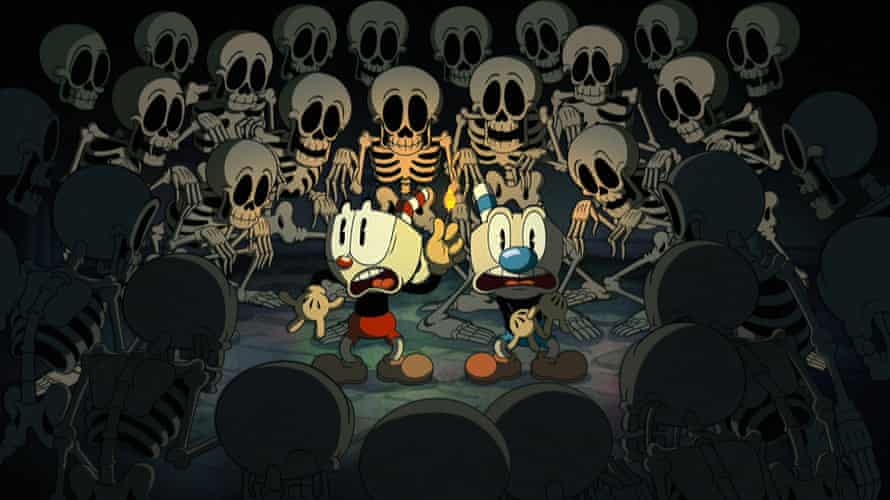Shared from www.theguardian.com
Few video games in recent years have managed to equal the sledgehammer disappointment of Cuphead. For those of you not in the know, Cuphead was an independent 2017 game that captured gamers’ imagination like little else before.
This was almost entirely down to how it looked. An out-and-out love letter to 1930s cartoonists such as Max Fleischer and Grim Natwick – with a main character inspired by a 1936 Japanese propaganda cartoon about an invasion of an evil Mickey Mouse army – Cuphead thrummed with a gloriously authentic Betty Boop feel. The animations were hand-drawn and imperfect. The big-band jazz soundtrack was recorded on analogue. The voices crackled and hissed as if recorded from worn vinyl. No detail was spared, to the extent that the creators had to remortgage their home to pay for it. And people fell for Cuphead hard. After some initial footage was shown as proof of concept, anticipation hit fever pitch and stayed there for three years.
But then the game came out, and it sort of sucked. It might have looked and sounded beautiful, but it was also cripplingly difficult to play. One early reviewer (who plays games for a living, remember) noted that he had died 188 times during the game. It seemed like such a wasted opportunity.
And yet, despite this, the kernel of Cuphead remained irresistible. The characters were so engaging, and the aesthetic so beautiful, that a small cottage industry sprang up around it. You might not be able to get past the level where you have to steal the soul from a giant onion (long story), but you could still buy Cuphead dolls and Cuphead books, and you could visit YouTube and watch a seemingly limitless number of users create no end of Cuphead songs, cartoons and comparison videos. The game might have caused you to rip out your hair in frustration, but the characters were too charming to be dismissed.
Which brings us to The Cuphead Show! (Netflix), in which the Cuphead characters are given their own series of 15-minute cartoons. It might sound complicated – a cartoon based on a game based on a different cartoon – but go along with it. Because The Cuphead Show! feels like Cuphead reaching its most perfect form.
The show sees Cuphead (a headstrong and cocky sentient cup) and his brother Mugman (in effect, a differently coloured Cuphead created solely to allow a two-player mode on the game, here beefed up into a cowardly Luigi type) as they blunder through a succession of wacky misadventures. While there’s a loose nod to the game’s plot – in which Cuphead and Mugman lose their souls by gambling with the devil, who in turn forces them to chase down his debtors – this is by no means a dramatisation.
Instead, The Cuphead Show! is a collection of standalone cartoons that have fun splashing around in the tropes of the era its animation was inspired by. This is the sort of cartoon where characters find babies abandoned by their front door, where radio antennas broadcast concentric circles and morse code, where down-and-outs still have the self-esteem to dress themselves in raggedy suits. It is at once a giddy genre exercise and something that your kids would happily watch. For the most part, that is. There’s one scene near the end of the series, where the devil mutates into a series of wild animals, that has the potential to ruin a couple of bedtimes. But, again, for a show that deliberately harkens back to a time where entertainment wouldn’t hesitate to scare kids, that’s probably par for the course.
Weirdly, though, Cuphead’s period frills don’t feel quite as authentic on TV. This is partly a tonal thing. Cuphead the game was so rigorously 1930s in its outlook that one of the levels saw him standing in an ashtray, fighting a barrage of cigars and cigarettes, and that would obviously be unthinkable to place in a children’s TV show in the 21st century. But it’s also down to execution, too. Although the surface touches are there – the screen is flecked with dust marks – the characters often carry the sterile perfection of computer animation, while the voices are recorded a little too cleanly. You can understand why these compromises were made, since two and a half hours of hand-drawn animation would be prohibitively expensive, but for a property that prides itself on authenticity, it can sometimes take you out of the moment a little.
These are just niggles, though. All in all, The Cuphead Show is an overwhelming success. It’s fast and funny and knowing, and you almost certainly won’t die 188 times watching it. What’s not to like?
Images and Article from www.theguardian.com

